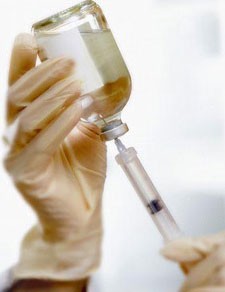|
 Use :
Use :
Prophylaxis of thromboembolic disorders (particularly deep venous
thrombosis and pulmonary embolism) in general and orthopedic
surgery; treatment of deep venous thrombosis; prevention of
clotting during hemodialysis
 Pregnancy Risk Factor B :
Pregnancy Risk Factor B :
Contraindications Hypersensitivity to nadroparin or any component
of the formulation; acute infective endocarditis; hemorrhage or
increased risk of hemorrhage (hemostasis disorder), except for
disseminated intravascular coagulation (DIC) not induced by
heparin; history of thrombocytopenia with nadroparin; organic
lesions likely to bleed (active peptic ulceration); hemorrhagic
cerebrovascular event; severe uncontrolled hypertension; diabetic
or hemorrhagic retinopathy; injuries to or operations on the CNS,
eyes, or ears. Not for I.M. administration.
 Warnings/Precautions :
Warnings/Precautions :
Patients with recent or anticipated neuraxial anesthesia
(epidural or spinal anesthesia) are at risk of spinal or epidural
hematoma and subsequent paralysis. Consider risk versus benefit
prior to neuraxial anesthesia. Risk is increased by concomitant
agents which may alter hemostasis, as well as traumatic or
repeated epidural or spinal puncture. Patient should be observed
closely for bleeding if nadroparin is administered during or
immediately following diagnostic lumbar puncture, epidural
anesthesia, or spinal anesthesia.
Not to be used interchangeably (unit for unit) with heparin or any
other low molecular weight heparins (LMWHs). Use with caution in
patients with history of heparin-induced thrombocytopenia. Rare
cases of thrombocytopenia with thrombosis have occurred. Use
caution in patients with congenital or drug-induced
thrombocytopenia or platelet defects. Discontinue therapy if
platelets are <100,000/mm3.
Monitor patient closely for signs or symptoms of bleeding. Certain
patients are at increased risk of bleeding. Risk factors include
bacterial endocarditis; congenital or acquired bleeding disorders;
active ulcerative or angiodysplastic GI diseases; severe
uncontrolled hypertension; hemorrhagic stroke; recent brain,
spinal, or ophthalmology surgery; concomitant treatment with
platelet inhibitors; recent GI bleeding; thrombocytopenia or
platelet defects; severe liver disease; hypertensive or diabetic
retinopathy; or in patients undergoing invasive procedures. Use
with caution in patients with severe hepatic or renal disease.
Safety and efficacy in pediatric patients have not been
established.
Heparin can cause hyperkalemia by affecting aldosterone. Similar
reactions could occur with LMWHs. Monitor for hyperkalemia. Do not
use when abortion is imminent or threatened.
 Adverse Reactions Frequency not defined.
Adverse Reactions Frequency not defined.
Dermatologic: Rash
Endocrine & metabolic: Hypoaldosteronism (causing hyperkalemia
and/or hyponatremia)
Hematological: Bleeding, thrombocytopenia
Hepatic: ALT/AST increased
Local: Injection site hematoma, pain at injection site
Neuromuscular & skeletal: Osteopenic effects
Miscellaneous: Allergic reactions
 Drug Interactions :
Drug Interactions :
Antiplatelet drugs: Drugs which affect platelet function (eg,
aspirin, NSAIDs, dipyridamole, ticlopidine, clopidogrel) may
increase the risk of hemorrhage.
Thrombolytics (fibrinolytics): Increase risk of hemorrhage.
Warfarin: Risk of bleeding may be increased during concurrent
therapy. Nadroparin is commonly continued during the initiation of
warfarin therapy to assure anticoagulation and to protect against
possible transient hypercoagulability.
 Dosage S.C.: Adults:
Dosage S.C.: Adults:
Prophylaxis of thromboembolic disorders in general surgery: 2850
anti-Xa int. units once daily; begin 2-4 hours before surgery and
continue for 7 days
Prophylaxis of thromboembolic disorders in hip replacement: 38
anti-Xa int. units/kg 12 hours before and 12 hours after surgery,
followed by 38 anti-Xa int. units/kg/day up to and including day
3, then 57 anti-Xa int. units/kg/day for up to 10 days total
therapy
Treatment of thromboembolic disorders: 171 anti-Xa int.
units/kg/day to a maximum of 17,100 int. units; plasma anti-Xa
levels should be 1.2-1.8 anti-Xa int. units/mL 3-4 hours
postinjection
Patients at increased risk of bleeding: 86 anti-Xa int. units/kg
twice daily; plasma anti-Xa levels should be 0.5-1.1 anti-Xa int.
units/mL 3-4 hours postinjection
Prevention of clotting during hemodialysis: Single dose of 65
anti-Xa int. units/kg into arterial line at start of each dialysis
session; may give additional dose if session lasts longer than 4
hours
Patients at risk of hemorrhage: Administer 50% of dose
Dosage adjustment in renal impairment: Reduced dose recommended
 Dosage Forms Injection, solution, as calcium:
Dosage Forms Injection, solution, as calcium:
Nadroparin :
9500 anti-Xa int. units/mL (0.2 mL, 0.3 mL, 0.4 mL) [ungraduated
prefilled syringe]
9500 anti-Xa int. units/mL (0.6 mL, 0.8 mL, 1 mL) [graduated
prefilled syringe]
Nadroparin Forte: 19,000 anti-Xa int. units/mL (0.6 mL, 0.8 mL,
1 mL) [graduated prefilled syringe]
|







